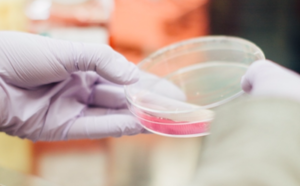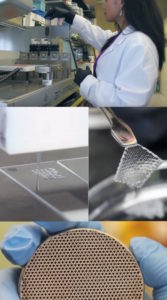3D printing has taken the world by storm. This fast and low-cost additive manufacturing technique have been making impacts in a range of industries including construction, manufacturing, and medicine. In 2014 alone, the 3D printing industry grew 35.4%, and the market is expected to continue growing toward a total value of $23 billion by 2022.
 Utilizing 3D printing in medicine is a relatively new technology, but it is quickly becoming a vital component in many treatment breakthroughs.
Utilizing 3D printing in medicine is a relatively new technology, but it is quickly becoming a vital component in many treatment breakthroughs.
The EnvisionTEC Bioplotter is a top 3D printer for medical applications. This printer has already been utilized by labs across the country in over 150 research studies. Its unique ability to print with any biomaterial and integrate multiple materials into a single print open up a world of possibilities.
The EnvisionTEC Bioplotter can print with any biomaterial and can integrate multiple materials into a single print.
EnvisionTEC Bioplotter: Case Studies
Custom Prosthetics
The EnvisionTEC Bioplotter makes it easy to create custom prosthetics quickly and at a fraction of the cost of traditional methods. Given the unlimited range of materials the printer can utilize, prosthetic designers can explore various materials and designs to figure out the ones that are most similar to the ones they are replacing. This exploratory ability helps designers and users customize prosthetics to their unique needs and mimic human movements.
3D printing provides a low-cost solution to create fully customized prosthetics that meet the unique needs and specifications of the user.
In this case study, the EnvisionTEC Bioplotter was used to make components for a custom hand prosthetic. Designers used polycaprolactone to print knuckle and joint components because of its similar properties to cartilage. Designers are able to further customize the prosthetic by trying different inner structuring patterns to create more rigid or flexible components. Using 3D printing in medicine this way provides a fast and low-cost alternative for creating fully customized and unique prosthetics.
The Shah Lab
The Shah Lab at Northwestern University regularly utilizes the amazing capabilities of the 3D printers in their work. Specifically, the Shah lab has used the EnvisionTEC Bioplotter in the following studies:
 Functional materials: One of the main focuses of the lab is to develop functional materials that can be used for other medical 3D printing techniques and treatments. They focus their attention on particle-based inks and hydrogel systems. Particle-based inks can be created for printing a range of materials including ceramics, metal, or tissue, while hydrogel printing systems are used to create complex organ and tissue systems.
Functional materials: One of the main focuses of the lab is to develop functional materials that can be used for other medical 3D printing techniques and treatments. They focus their attention on particle-based inks and hydrogel systems. Particle-based inks can be created for printing a range of materials including ceramics, metal, or tissue, while hydrogel printing systems are used to create complex organ and tissue systems.
The Shah Lab focuses on developing functional biomaterials using particle-based inks and hydrogel systems.
Using the EnvisionTEC Bioplotter, scientists are able to print multiple materials together utilizing grafting techniques that assist in the regeneration of organs and muscle tissue. These types of amazing medical breakthroughs are what makes 3D printing in medicine so exciting. In the future doctors will be able to print custom organs for transplants rather than having to rely on the depleting organ donor bank.
Liver regeneration: Through their development of functional biomaterials, the Shah Lab has created a technique that assists in the regeneration of liver cells. The liver is one of the few organs in the body that can regenerate on its own, but this natural process can stop due to a variety of diseases and other ailments. Liver donation and transplantation is an extremely expensive and dangerous procedure. Besides the challenges of finding a liver donor, the possibility of organ rejection by the body is high.
It can be difficult to find liver donors and there is a risk that the organ could be rejected by the body.
Using the techniques developed by the Shah Lab, doctors can 3D print cells to create an in vitro liver construct that gets implanted into the patient and regrown into a full-sized and functional liver. This procedure removes the need for organ donors and since the patient’s own cells are used, significantly reduces the potential for rejection.
Improve fertility in cancer patients: Cancer treatment can be extremely destructive to the human body and can cause infertility in women. This can be devastating, especially for women who have yet to start families. The Shah lab has developed a technique using their particle-based inks to 3D print ovaries, a process called ovary bioprosthesis.
Ovary bioprosthesis has the potential to help infertile women start their own families.
So far, this medical breakthrough has had positive results in mice. Scientists have successfully implanted 3D printed ovaries into sterilized mice and then had them reproduce healthy offspring. Although further testing is required before this technique can be used in humans, this treatment has the potential to change the lives of not only women who have undergone cancer treatment, but other women who struggle with infertility around the world.
Printing Heart Valves
3D printing in medicine has already been able to make headway in fixing broken hearts. The EnvisionTEC Bioplotter has been utilized in the creation of aortic leaflet heart valves. Taking advantage of 3D printing and scanning technologies, doctors have the ability to scan patients to understand their unique heart problems, and then use 3D design software to design and print a valve that is customized to the exact size needed for the patient.

To print the heart valve, doctors use the EnvisionTEC Bioplotter to layer alternating scaffold and support materials in the desired shape. Once the printing process is completed, the entire valve is placed in warm water causing the supporting material to dissolve. Afterwards, doctors are left with a valve that can be implanted directly into the patient or utilized for testing. This medical breakthrough will help individuals suffering from various cardiac ailments to live longer and happier lives.
3D Printing in Medicine Using the EnvisionTEC Bioplotter
3D printing in medicine has revolutionized medical treatments, by not only making the previously impossible possible but also by lowering the price of many advanced procedures.

The future possibilities of 3D printing in medicine will help solve many of the issues we have in healthcare today. Printing organs and customized prosthetics will allow people to live longer and healthier lives.
The endless capabilities that are possible using the EnvisionTEC Bioplotter’s unique and flexible multi-material system will continue helping in future medical developments.
Interested in purchasing the EnvisionTEC Bioplotter or have additional questions? Contact us for more information.

